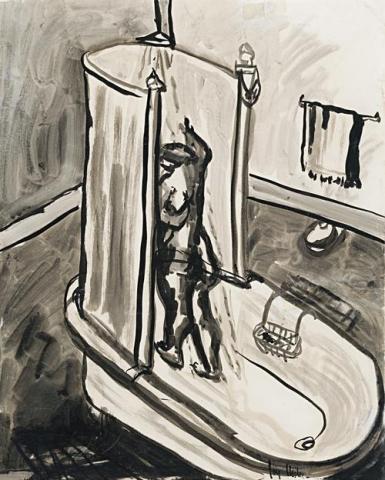WOMAN IN THE SHOWER, c.1945
Joy Hester
brush and ink on paper
50.5 x 40.5 cm
signed lower right with artist's estate stamp
The Reed Family Collection, Victoria
Joy Hester is a very singular artist whose striking individuality gives her works such authority. Images of the diurnal task of the morning shower or at the bar of the local pub (lot 80) take on, under her gifted hand, a new significance, heightened by the directness of approach and starkness of presentation, much aided by the choice of medium. They are, as the idiom goes, 'in black and white', with all the associated implications of being clearly defined and more credible than words. To give added point, she makes great use of awkwardness - the ungainly back view of the showering figure, the angles of the elbows and shoulders of the two at the bar - each communicating something of the experienced and felt rather than the merely seen. The frontality of the latter invites participation in their conversation and adds much to the overall pictorial design with its own engaging and revealing, if not chatty lines. This is taken up in the faces - in the quizzical response of the barman to the tale told by his mate. The environment would have been familiar to Hester as she worked part-time as a drink waitress and telephonist during the Second World War.
The intensity of her images as well as their ability to communicate so effectively is due in part to the spontaneity and immediacy of her expression, freely and rapidly recorded to catch the nuance of the moment or the relationship. Her technique was ideally suited to the purpose of her art, as her biographer Janine Burke perceptively put it, 'to convey expressively the relationships between people.'1 For Hester, art was part of life, each drawing on the other, as so clearly seen in Woman in the Shower. 'To her,' Burke observed, 'the commonplace was special and valuable and she put up no barriers, indeed did not recognize them, between herself and the avalanche of small, trivial fragments that comprise all our lives.'2 Nevertheless, Hester shows that, even in the most mundane moments, the complexities and contradictions of life intrude. While there are certainly no barriers present in this drawing, the presentation of the nude female figure is almost brutal in its ungainly frankness. And who feels glamorous in the shower first thing in the morning! Nevertheless, the everyday and the darkness visible in the isolation of bathroom are swept away by the verve and passion of the brush strokes flowing spontaneously from the personality of the artist. As Barrie Read said, 'To say that Joy Hester was a unique artist is not to enthuse but to define.'3
1. Burke, J., Joy Hester: art and life, National Gallery of Victoria, Melbourne, 1981, p. 5
2. ibid
3. Reid, B., 'Joy Hester: Draughtsman of Identity', Art and Australia, vol.4, no. 1, June 1966, p. 45
DAVID THOMAS
